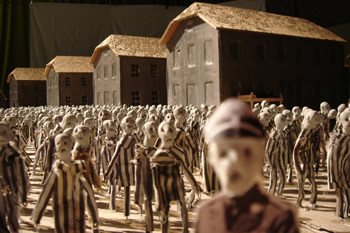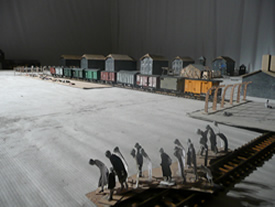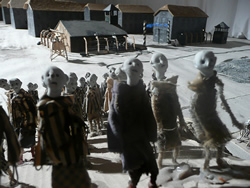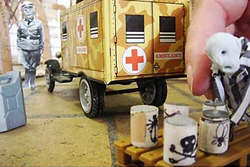
Shadow Puppets
By Martin Harries
Kamp
By Hotel Modern
Great Small Works 9th Annual Toy Theater Festival
St. Ann's Warehouse
(closed)
Pauline Kalker, a founder of the Dutch
theater company Hotel Modern, never uses the word toy when referring
to her company's work "Kamp," a 36-by-33 foot model of Auschwitz
populated by 3,000 three-inch-tall figures.
"The word is not in our vocabulary," said Ms. Kalker . . . "We
are making a live action animation film onstage."
-- Patricia Cohen, "Miniatures Amplify
a Story of Horror," The New York Times, 1 June 2010
Three grim adults crouch over a modified
reconstruction of the concentration camp at Auschwitz-Birkenau.
With a small camera, one of the three shoots scenes from the daily
life of the camp, performed by simple figures. Sometimes the audience
cannot directly see what the puppeteers are doing, and the minute
size of the figures in any case makes it hard to see what transpires
with much clarity. A projector makes scenes visible on a screen
upstage. To most viewers, these scenes will be familiar, but they
remain horrible, and viscerally so when, for instance, one puppet
wielding a truncheon again and again strikes another puppet. Amplified
sound accentuates the disturbing effect of this beating.
In one sequence, Kamp focuses
not on the victims themselves but on the possessions they have
been forced to surrender. The poignancy of these objects is familiar
-- the subject of a memorable sequence, for instance, in Schindler's
List. Nevertheless, when the victims are themselves "performing
objects," to use a phrase popularized by John Bell, objects stolen
from them take on a different charge. In Kamp, the camera
scans open suitcases: clothing, a pair of binoculars, a menorah.
And toys: stuffed animals. How miniscule must that elephant be,
to be a toy for a three-inch-tall "child"?
The affective force of these objects conjures
daily lives that ended with the arrival at the death camp. "Auschwitz."
"Toy." Words from vocabularies that do not overlap. Just as there
could be no toys in Auschwitz, so Auschwitz must not become a
toy. To distance Kamp and its miniscule figures from
toys -- and thereby to distance these performances from play --
is understandable. As became clear in the uproar around Zbigniew
Libera's Lego concentration camp sets of 1996, to make a toy of
the Holocaust is to risk accusations of obscenity. "The word is
not in our vocabulary."
 And
yet words not in vocabularies can be the words most needed. To
call Kamp a performance using toys might seem to suggest
that it trivializes Nazi genocide. However, to shut down the possibility
that the puppets of Kamp might resemble toys eliminates
a crucial framework for understanding the piece. While not so
grave a risk as trivializing Auschwitz, there is also a risk in
refusing to recognize play. Surely these three human performers,
moving methodically and deliberately among the models, resemble
nothing so much as serious children at play. When Herman Helle
brings a train into the station the contrast is especially sharp:
he both resembles an earnest boy with his toy train set and re-enacts
one of the paradigmatic scenes of mechanized inhumanity. To pretend
that we do not see the earnest boy would be to erase the serious
play that seems to me what justifies the performance.
And
yet words not in vocabularies can be the words most needed. To
call Kamp a performance using toys might seem to suggest
that it trivializes Nazi genocide. However, to shut down the possibility
that the puppets of Kamp might resemble toys eliminates
a crucial framework for understanding the piece. While not so
grave a risk as trivializing Auschwitz, there is also a risk in
refusing to recognize play. Surely these three human performers,
moving methodically and deliberately among the models, resemble
nothing so much as serious children at play. When Herman Helle
brings a train into the station the contrast is especially sharp:
he both resembles an earnest boy with his toy train set and re-enacts
one of the paradigmatic scenes of mechanized inhumanity. To pretend
that we do not see the earnest boy would be to erase the serious
play that seems to me what justifies the performance.
This formulation of course invites a return
to the implicit counter-argument: Auschwitz as a site of industrialized
genocide simply does not allow for play. Certainly the screened
scenes of Kamp erase every example of resistance, every
"moment of reprieve," to use Primo Levi's phrase. Life is not
beautiful. The performance is not an exhaustive survey of the
whole dystopian city: there is scarcely a hint of the camp's strata
or of the marginally less deprived circumstances of those who,
like Levi, had skills that kept them alive. Kamp shows
us "Kanada," that section of the camp where a group of more privileged
women sorted seized possessions, but one can have no inkling that
Kitty Hart, a survivor of this group, performed a three-act play
while there (as she later recalled). Kamp instead focuses,
entirely justifiably, on the brutally simple narrative invoked
by "Auschwitz": a city designed to kill people.
 The
screened scenes, that is, are unremitting in their focus on the
horror of the place. And one of the surprising effects of the
puppets is that the audience experiences this horror in part vicariously.
A new group of prisoners arrives by train: we watch the performers
lift flats from inside the cars, each containing the figures of
many prisoners. The camera then scans the group. They are disconcertingly
well-dressed: the men in suits and ties, the women in dresses.
Their clothing will be the last marker of sexual difference in
the piece. What is most striking in this sequence is the way their
eyes, simply holes gouged into their faces, register their encounter
with the place they could not have imagined. The mobile camera
surveys their still bodies, and the audience sees an accumulation
of terror. (In the Times, Patricia Cohen rightly compares
these faces to "Munch-like howls.") Very often, the liveness of
this "live animation film" belongs not to the stationary puppets
themselves, but to the camera that surveys them. The tableaus
of horror culminate in a survey of puppet corpses: one survivor
of the gas chamber struggles to move, and collapses.
The
screened scenes, that is, are unremitting in their focus on the
horror of the place. And one of the surprising effects of the
puppets is that the audience experiences this horror in part vicariously.
A new group of prisoners arrives by train: we watch the performers
lift flats from inside the cars, each containing the figures of
many prisoners. The camera then scans the group. They are disconcertingly
well-dressed: the men in suits and ties, the women in dresses.
Their clothing will be the last marker of sexual difference in
the piece. What is most striking in this sequence is the way their
eyes, simply holes gouged into their faces, register their encounter
with the place they could not have imagined. The mobile camera
surveys their still bodies, and the audience sees an accumulation
of terror. (In the Times, Patricia Cohen rightly compares
these faces to "Munch-like howls.") Very often, the liveness of
this "live animation film" belongs not to the stationary puppets
themselves, but to the camera that surveys them. The tableaus
of horror culminate in a survey of puppet corpses: one survivor
of the gas chamber struggles to move, and collapses.
Along with the intimations of serious
play, there are also suggestions of horror movies: the audience
watches giants terrorize minute prisoners with a camera. The hollow-eyed
prisoners taking in the enormity of Auschwitz seem also to be
seeing the hulking puppeteers who make them move. Susanne Lammers,
in a Dutch review, comments on "the impassiveness that characterises
the three performers' silent and determined efforts to bring the
events to life": "This is alienating and sinister. In its efficiency
it recalls the way in which a concentration camp was run." Such
efficiency is especially clear when the three, with the care of
a crack fire brigade, set up the hundreds of small figures for
the roll call.
The homology between the well-calculated
performance and the horrific efficiency of the place it represents
is unmistakable, and yet surely this similarity does not mean
one must condemn the performance as itself horrific. Why repeat
these scenes? Walter Benjamin's discussion of why a child wants
"the same thing again and again, a hundred or even a thousand
times" offers a clue. His answer:
This is not only the way to master frightening
fundamental experiences -- by deadening one's own response,
by arbitrarily conjuring up experiences, or through parody;
it also means enjoying one's victories and triumphs over and
over again, with total intensity. An adult relieves his heart
from its terrors and doubles happiness by turning it into a
story. A child creates the entire event anew and starts again
right from the beginning. Here, perhaps, is the deepest explanation
for the two meanings of the German word Spielen ["to
play" and "games"]: the element of repetition is what is actually
common to them. Not a "doing as if" but a "doing the same thing
over and over again," the transformation of a shattering experience
into habit - that is the essence of play. ("Toys and Play,"
in Selected Writings, vol. 2)
Kamp, in a little under an hour,
provides a theatrical abstract of Auschwitz. The effect of the
piece doesn't lie in novelty of subject matter. On the contrary,
it relies on the spectator's having some knowledge of what transpired
there -- in complexly mediated ways, it repeats something known.
There is no dialogue: a soundtrack provides the scenes' sonic
complement. No narration provides captions for what we are seeing,
as if to suggest that this is a fundamental experience that cannot
be mastered in linguistic form.
 Kamp
literalizes a metaphor: all agency lost, the victims of tyranny
become puppets. The performers refuse even that ventriloquism
that is the puppeteer's gift to the puppet. In refusing to speak
for these figures, Hotel Modern confesses the limits of its powers
to speak for or to mediate the experience of Auschwitz's victims.
The most evident of these forms of damaged mediation is the camera,
which produces stuttering scenes of terror. (A darkness around
the edges of the screened images recalls the effect of a pinhole
camera.) The most important form of mediation may, however, be
the presence of the humans who orchestrate this performance of
objects. Without the contrast between their ungainly presence,
their dour playfulness, and the scenes they have staged, there
would be no play.
Kamp
literalizes a metaphor: all agency lost, the victims of tyranny
become puppets. The performers refuse even that ventriloquism
that is the puppeteer's gift to the puppet. In refusing to speak
for these figures, Hotel Modern confesses the limits of its powers
to speak for or to mediate the experience of Auschwitz's victims.
The most evident of these forms of damaged mediation is the camera,
which produces stuttering scenes of terror. (A darkness around
the edges of the screened images recalls the effect of a pinhole
camera.) The most important form of mediation may, however, be
the presence of the humans who orchestrate this performance of
objects. Without the contrast between their ungainly presence,
their dour playfulness, and the scenes they have staged, there
would be no play.
Benjamin's emphasis on play as a form
of psychic mastery and on the transformation "of a shattering
experience into habit" helps to describe the ambiguous power of
Kamp. In relation to the Holocaust, there can be no question
of mastery: this goes almost without saying. And yet, precisely
in its combination of the awkwardly handmade and the elaborately
choreographed, Kamp captures a need to repeat, to try
to know what cannot fully be known. Through its forms of serious
play, it reminds the audience of the necessity of repeatedly trying
to know, and also of the inevitable failures of knowledge and
of mastery alike.
